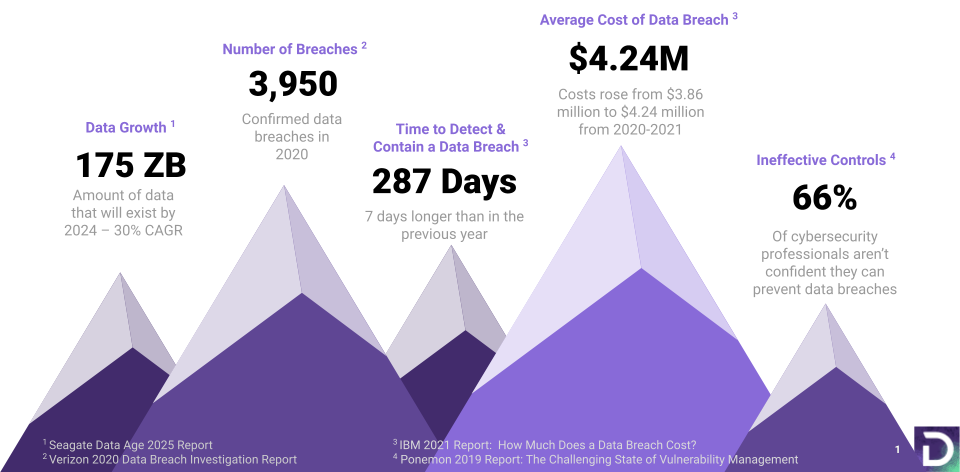
With mankind on a race to digitize every aspect of our life, from the way we own and operate our businesses to the way we use technology to stay connected in our own personal lives, it’s not surprising that we live in a world where our digital footprint is ever-increasing. In addition, given how inexpensive and convenient cloud storage is, companies are keeping more and more of the data we generate.
But with all life processes, there’s a natural give and take. The more data companies keep, the more difficult it is for them to protect and keep it safe. And with hackers on the rise to disrupt and terrorize our lives in countless new ways with smarter, more sophisticated attacks, data breaches just keep getting worse and more expensive.
It’s a perplexing puzzle that data security companies can’t seem to solve.
This is the current state of security, and it’s extremely disconcerting.

Data Explosion and Higher Risk in Securing Sensitive Data
According to the Seagate Data Age 2025 Report, digitization occurs in 3 primary locations: “the core (traditional and cloud datacenters) the edge (enterprise-hardened infrastructure...), and the endpoints (PCs, smart phones, and IoT devices).” By 2025, the IDC predicts that most data will be stored in the public cloud, and that the amount of data will grow to 175 zettabytes – a never-before-seen explosion of data at this scale. The desire to capitalize and leverage this data to fuel business growth, however, comes at a grave cost: higher risk. With an increasingly complex architecture and a growing number of users with access to data, the ability to manage and secure sensitive data is more challenging than ever.
Double the Number of Data Breaches in 2021
Time and time again, we’ve seen some of the most prominent businesses suffer a data breach. At the end of the day, businesses – big or small – are not invincible, and malicious attacks will always leave a disaster in its wake, a scramble to secure the aftermath, and a formidable journey to regain the trust of millions. It’s time we change the script. In its 2020 Data Breach Investigations Report, Verizon analyzed more than 30,000 security incidents from 81 different companies and countries across 16 verticals. With 86% of data breaches as a means for financial gain, the report revealed just how money-hungry these attackers really are. In 2020, there were 3,950 confirmed data breaches, almost double from last year. There’s clearly something broken in data security. In order to protect themselves, their data, and the people they serve, organizations need to fundamentally rethink data security.
Increased Cost and MTTD a Data Breach
Every year, the threat landscape changes. New actors enter and leave the playing field, and new attacks are launched every day. It’s a war that never seems to end, but in 2021, the attackers are gaining the advantage. In the 2021 Cost of a Data Breach Report, IBM teamed up with the Ponemon Institute to study 537 data breaches across 17 different regions and industries. Shocking results from the report revealed that companies have not equalized the playing field, but are rather lagging behind. The average number of days to detect and contain a data breach has increased to 287 days – 7 days longer than the year before. And to make matters worse, the stakes are much higher. The average cost of a data breach has now climbed to $4.24 million. Even faced with higher monetary and reputational costs, companies are struggling to make meaningful progress in the data security battle.
Ineffective Controls and Lack of Confidence in Preventing Data Breaches
A survey conducted by the Ponemon institute of over 600+ cybersecurity leaders and professionals across 15+ verticals found that only 1 in 3 organizations are confident they can avoid data breaches. This means 66% of organizations aren’t confident they can prevent data breaches. According to Larry Ponemon, the founder and chairman of the Ponemon institute, the 2019 Challenging State of Vulnerability Management Ponemon Report reveals that companies are not only “under-resourced in finding and managing their vulnerabilities, but they also have gaps in assessing the risk and getting full visibility across their IT assets.” Though the low confidence level is worrisome, the results aren’t surprising. With the sheer volume of alerts and the velocity of the cloud, it’s no surprise that security teams have difficulty protecting sensitive data throughout their environment. They’re forced to make a high volume of decisions with limited context, and as a result, fall victim to some of the worst cyber crimes in history.
To learn more about how to protect your data in an ever-changing world, visit www.dasera.com.









